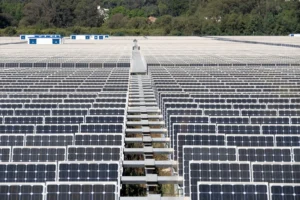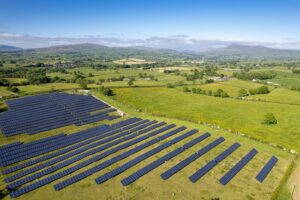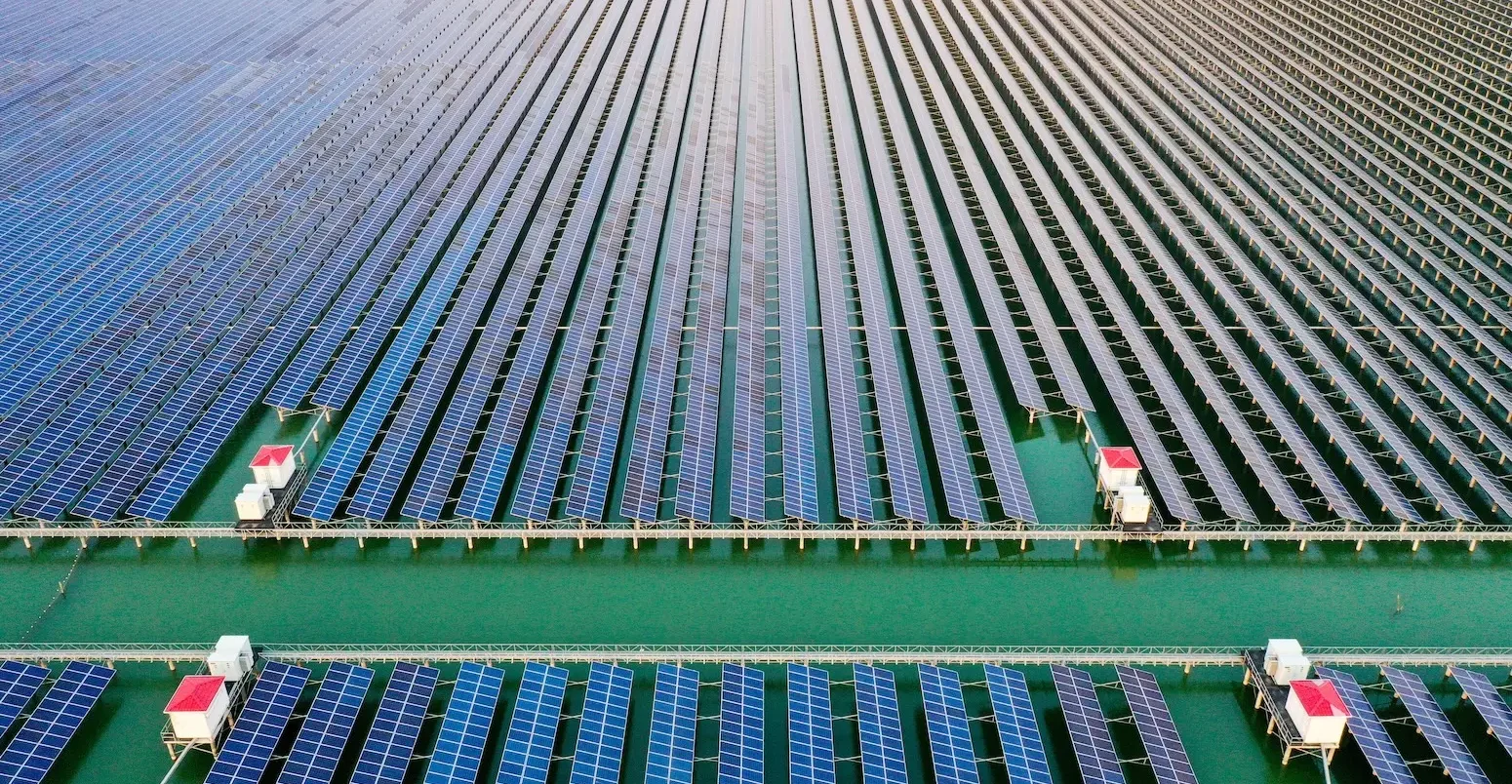
Power-sector CO2 hits ‘all-time high’ in 2024 despite record growth for clean energy
Molly Lempriere
04.08.25Molly Lempriere
08.04.2025 | 12:01amGlobal power-sector emissions hit an “all-time high” in 2024, despite solar and wind power continuing to grow at record speed, according to analysis from thinktank Ember.
Emissions from the sector increased by 1.6% year-on-year, to reach a record high of 14.6bn tonnes of carbon dioxide (tCO2).
This increase was predominantly due to a 4% growth in electricity demand worldwide, leading coal generation to increase by 1.4% and gas by 1.6%.
Embers’ analysis finds that the increase in fossil-fuel generation was, in particular, due to hotter temperatures in 2024, which drove up electricity demand in key regions such as India.
Clean electricity generation grew by a record 927 terawatt hour (TWh), which would have been sufficient to cover 96% of electricity demand growth not caused by higher temperatures.
Despite the increase in emissions in the short-term, this “should not be mistaken for failure of the energy transition”, notes Ember, but a sign the world is nearing a “tipping point” wherein changes in weather and demand hold a particularly strong sway.
Clean-power growth
Low-carbon energy sources – renewables and nuclear – provided 40.9% of the world’s electricity in 2024, according to Ember.
This is the first time they have passed the 40% mark since the 1940s, when hydropower contributed around that percentage and coal made up 55%.
Renewable power sources collectively added a record 858TWh of generation last year – a 49% increase on the previous record set in 2022 of 577TWh.
Solar dominated electricity generation growth for the third year in a row in 2024, adding 474TWh of generation, as shown on the chart below. This was up 29% on 2023.
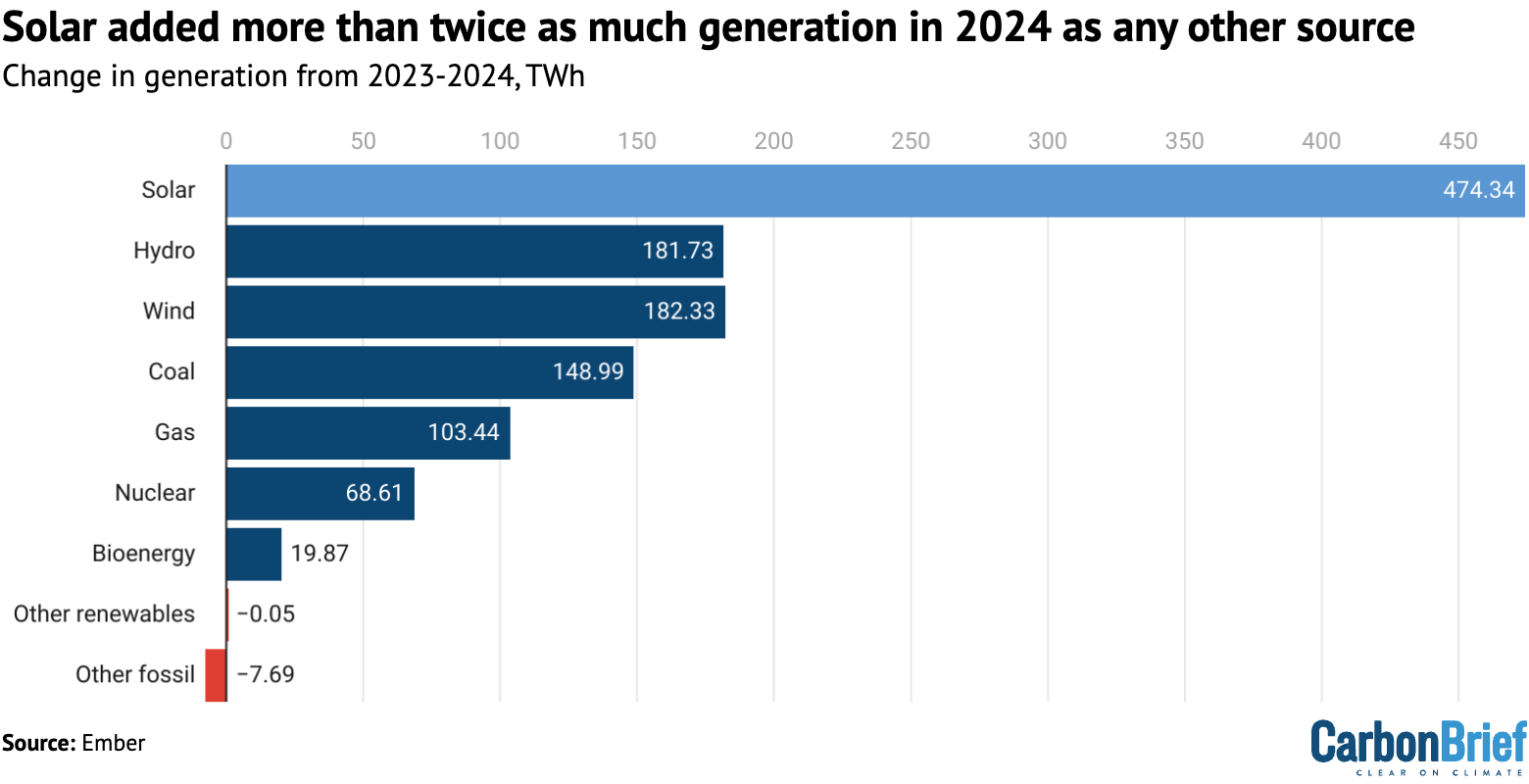
This allowed solar, which hit a total global generation of 2,131TWh, to meet 40% of global electricity demand growth in 2024 alone.
Solar generation “avoided” an estimated 1,658MtCO2 in 2024 – equivalent to the power-sector emissions of the US, according to Ember.
The technology’s significant growth in 2024 – with more solar capacity installed last year than annual capacity installations of all fuels combined in any year before 2023 – continues a trend seen over recent years.
Across 99 countries, the electricity they produce from solar power has doubled in the past five years.
In 2024, non-OECD economies accounted for 58% of global solar generation, with China accounting for 39% alone. A decade ago the 38 Organisation for Economic Co-operation and Development (OECD) countries – a group founded in 1961 to stimulate economic growth and global trade – made up 81% of global solar generation.
This shift follows the cost of solar falling more than 90% between 2010 and 2023, according to the International Renewable Energy Agency (IRENA). The low cost of the technology has been a key factor in deployment rising sharply worldwide.
It has also enabled new markets to emerge, with Saudi Arabia and Pakistan among the top importers of Chinese solar panels in 2024, according to a recent guest post on Carbon Brief.
In a statement, Phil MacDonald, Ember’s managing director said:
“Solar power has become the engine of the global energy transition. Paired with battery storage, solar is set to be an unstoppable force. As the fastest-growing and largest source of new electricity, it is critical in meeting the world’s ever-increasing demand for electricity.”
Wind generation also grew in 2024, although at a more moderate pace than solar power. Globally, there was an additional 182TWh of wind generation last year, or an increase of 7.9%.
Despite continued capacity additions, some geographies saw their lowest increase in wind generation in four years due to reduced wind speeds, notes Ember.
Hydro generation rebounded as drought conditions eased in 2023. This was particularly true in China, where generation increased 130TWh, it adds.
Coal generation grew to 10,602TWh and gas generation to 6,788TWh, an increase of 149TWh and 104TWh, respectively.
However, due to the increases in renewable generation – despite coal and gas generation increasing in absolute terms – their share of generation has fallen.
Coal generation has dropped from 40.8% in 2007 to 34.4% in 2024, according to Ember. The share of gas generation has fallen for four consecutive years now since its peak in 2020 at 23.9%, with 22% of the world’s electricity generation from gas in 2024.
The increase in fossil-fuel generation was virtually identical in 2024 as it was in 2023, despite electricity demand growing (245TWh vs 246TWh, respectively).
Increased demand in short-term
Emissions in the power sector grew by 223MtCO2, despite the increase in renewables due to fossil fuels being relied on to meet increased demand, according to Ember.
Electricity demand increased by 4% over 2024 to meet 30,856TWh globally – crossing the 30,000TWh point for the first time ever. This is up from a 2.6% increase seen in 2023.
Fossil-fuel generation rose to meet the additional demand increase of 208TWh that was specifically driven by higher temperatures, according to Ember.
This dynamic was particularly pronounced in countries that experienced strong heatwaves.
For example, heatwaves in India led to the country experiencing its hottest day on record, with the western Rajasthan state’s Churu city hitting 50.5C on 28 May.
Coal-generation growth met 64% of India’s electricity demand growth in 2024, according to Ember, including that created by air conditioning.
However, this is still less than 91% of electricity demand growth in 2023, highlighting India’s continued transition away from coal, despite short-term trends.
On a global basis, if 2024 had the same temperatures as 2023, fossil generation would have increased by just 0.2%, Ember notes.
As it was, renewables met three-quarters of demand increases, with coal and gas meeting the majority of the rest.
Alongside heatwaves, emerging sectors such as data centres and electric vehicles (EVs), had a modest impact on increased electricity demand.
Demand from data centres and cryptocurrency mining increased by 20% in 2024, adding 0.4% to global electricity demand.
EV electricity demand increased by 38% in 2024, adding 0.2% to global electricity demand.
Despite increasing electricity demand, the growth of fossil fuels is still expected to be nearing the end.
According to Ember, assuming typical capacity factors, solar generation is expected to grow at an average rate of 21% per year between 2024 and 2030. Similarly, wind is expected to grow 13% per year.
Together with modest hydro and nuclear power growth, clean generation is expected to increase by an average of 9% per year to the end of the decade, adding 8,399TWh of annual generation by 2030.
This increase would be sufficient to keep pace with an increase in demand of 4.1% per year to 2030, exceeding the International Energy Agency’s (IEA) “stated policies scenario” scenario forecast of 3.3%, as shown in the chart below.
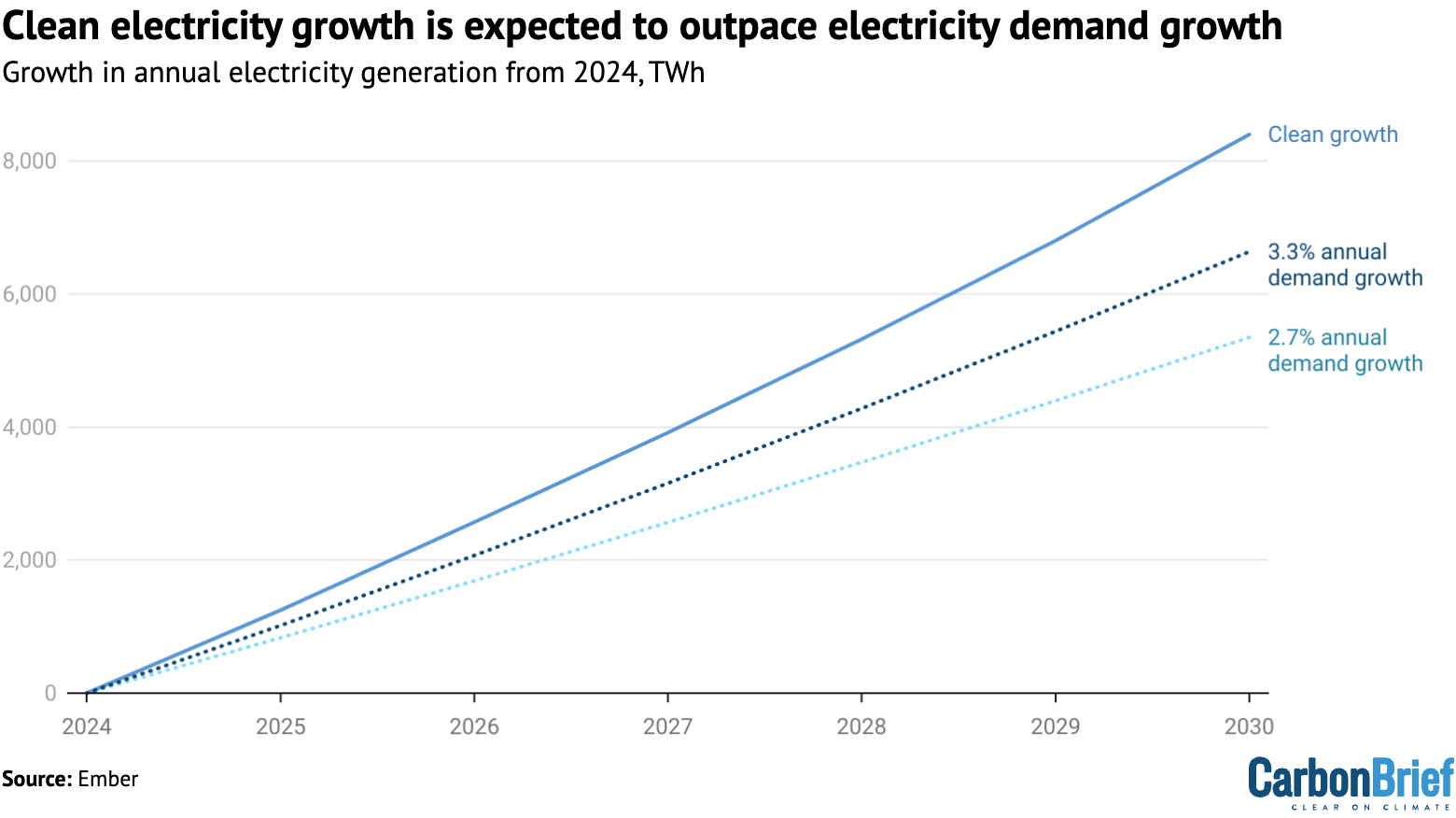
As such, over the next few years, while “changes in fossil generation in the short-term may be noisy, the direction and ultimate destination are unmistakable”, notes the Ember report, adding: “The global energy transition is no longer a question of if, but how fast.”
Many of the changes are expected to be partially determined by weather condition fluctuations from year to year.
Temperature effects impacted generation as well as demand. For example, if global weather conditions in 2024 had been in line with the five-year average, wind generation would have been 2TWh higher and hydro would have been 86TWh higher.
China and India
The world’s largest emerging economies are “on a path of clean electricity expansion that is set to reverse their power-sector fossil growth trends, tipping the global balance on fossil generation”, according to Ember.
China’s clean electricity additions met 81% of demand growth in 2024, due to record wind and solar capacity installations. This is the highest share since 2015 when the country saw its demand fall.
Its 623TWh increase in electricity demand was largely met by wind and solar, which collectively added 356TWh and a rebound in hydro generation which added 130TWh.
Fossil-fuel generation increased by 116TWh in 2024, a third of that seen in 2023, as shown in the chart below.
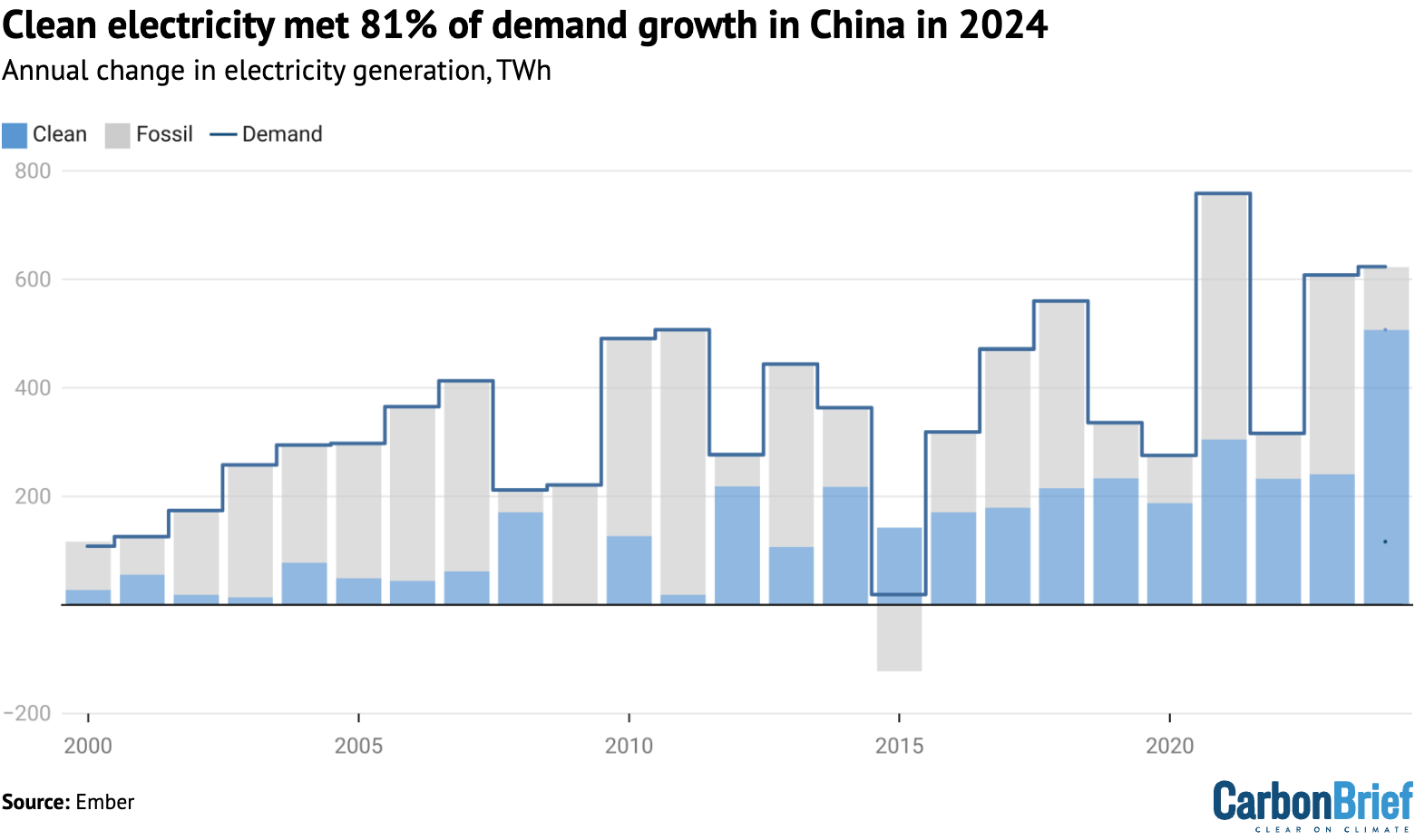
According to Ember, without the impact of hotter weather, clean generation would have met 97% of China’s rise in electricity demand in 2024.
The country’s renewables surge kept CO2 emissions below those for 2023 over the last 10 months of 2024, according to analysis for Carbon Brief.
Ember’s report suggests that India is likely to surpass China to become the country with the largest fossil-fuel generation growth in the coming years. Its fossil-fuel generation increase was the second-largest of any country in 2024 at 67TWh.
However, the cost of solar has fallen by 90% globally between 2010 and 2023. This has led to capacity increasing by 24 gigawatts of alternating current (GWac) in 2024 in India.
Currently, there are 143 gigawatts (GW) of wind and solar capacity under construction in the country, made up of 82GW of solar, 25GW of wind and 36GW of hybrid capacity.
Utility-scale projects already under construction as of January 2025 will nearly double India’s wind and solar capacity, notes Ember.
Elsewhere, wind and solar together generated 17% of the US’s electricity in 2024. The share of coal in the electricity mix fell below 15% – an all-time low – but gas generation rose, with the US accounting for more than half of the global gas generation increase in 2024.
Solar overtook coal generation in the EU for the first time in 2024 with the block seeing the largest fall in coal generation globally.


